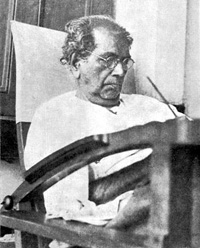Abanindranath Tagore


Abanindranath Tagore, the nephew of Rabindranath Tagore, was born on 7th August 1871. He was one of the most prominent artists of the Bengal school of painting, along with being the first major supporter of swadeshi values in the Indian art. Abanindranath is also regarded as a proficient and accomplished writer. The painter tried to modernize Moghul and Rajput traditions as an answer to the growing influence of Western art under the British Raj. With this biography, we are trying to throw light on the life history of Abanindranath Tagore:
Abanindranath Tagore was born in the Jorasanko town of West Bengal. The younger bother of Gaganendranath Tagore, an eminent artist, Abanindranath was introduced to art in the 1880s, when he was studying at the Sanskrit College. In the year 1889, he married Srimati Suhasini Devi, the daughter of Bhujagendra Bhusan Chatterjee. It was around this time that he left the Sanskrit College and joined St. Xavier's College as a special student for one and a half years.
In 1897, the Vice-Principal of 'Calcutta Government School of Art' started teaching the traditional European academic manner to Abanindranath Tagore. During that time, Tagore developed an interest in watercolors and also came under the influence of Mughal art. He made some beautiful paintings based on the life of Lord Krishna, reflecting a strong influence of the Mughal style. A meeting with E.B. Havell convinced Abanindranath Tagore to work with him in the process of the renewal of the style of teaching at the Calcutta School of Art.
His Style
Abanindranath Tagore believed in the traditional Indian techniques of painting. His philosophy existed in rejecting the materialistic art of the west and coming back to the Indian traditional art forms. He was very much influenced by the Mughal School of painting as well as Whistler's Aestheticism. In his later works, Abanindranath started integrating Chinese and Japanese calligraphic traditions into his style. The intention behind this move was to construct an amalgamation of the modern pan-Asian artistic tradition and the common aspects of Eastern spiritual and artistic culture.